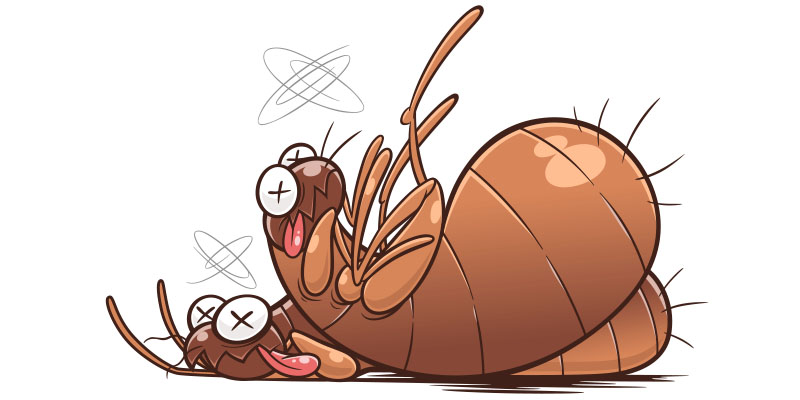Fleas are not just a nuisance – they can quickly multiply and infest your home, causing discomfort for both you and your pets. When faced with a flea infestation, many homeowners are eager to find an effective solution, but they often wonder: how much will it cost to get rid of these pesky pests?
In what follows, we’ll delve deep into the topic of flea pest control, exploring the various factors that can influence the cost of treatment and providing valuable insights to help homeowners make informed decisions. From understanding the extent of the infestation to considering different treatment options and evaluating the services of professional pest control companies, we’ll cover everything you need to know about the cost of pest control for fleas. So, if you’re grappling with a flea problem and wondering how much it will set you back, read on to learn more!
Fleas are small, wingless insects with flattened bodies that are designed for easy movement through the fur or feathers of their hosts. Here are some of their physical characteristics:
- Size. Adult fleas typically measure between 1 to 4 millimeters in length, making them barely visible to the naked eye.
- Color. Fleas are usually reddish-brown in color, although their hue may vary depending on their species and diet.
- Body structure. Fleas have strong, robust legs that enable them to jump impressive distances relative to their size. They also possess piercing mouthparts adapted for feeding on the blood of their hosts.
Fleas primarily enter homes through a variety of means, often hitching rides on pets, rodents, or other animals. Once inside, fleas can quickly multiply under favorable conditions. Female fleas lay their eggs on their host animals, which then fall off onto bedding, carpets, and other surfaces.
These eggs hatch into larvae, which feed on organic debris found in the environment. After several weeks, the larvae spin cocoons and undergo metamorphosis into adult fleas. The newly emerged adult fleas then seek out hosts to feed on and continue the cycle. For these reasons, fleas are notoriously difficult to eradicate without professional pest control services because of the following factors:
- Rapid reproduction. Fleas reproduce quickly, with female fleas capable of laying hundreds of eggs in a short period. This rapid reproduction makes it challenging to eliminate fleas entirely through DIY methods alone.
- Resilience. Flea eggs, larvae, and pupae can survive in the environment for extended periods, even in the absence of hosts. This resilience allows fleas to persist in the home and reinfest the environment even after initial treatment.
- Hidden habitats. Fleas and their eggs can hide in carpets, upholstery, bedding, and other hard-to-reach areas, making it difficult to target and eliminate them effectively without professional expertise and specialized equipment.
- Resistance to treatment. Over time, fleas may develop resistance to common pesticides and insecticides used in DIY treatments, reducing the efficacy of these methods. Professional pest control services have access to a wider range of products and techniques that can effectively target fleas and break the infestation cycle.
Overall, the combination of rapid reproduction, resilience, hidden habitats, and potential resistance to treatment makes fleas a formidable pest to tackle without professional intervention. Engaging the services of a professional pest control provider can help homeowners effectively eliminate fleas and prevent future infestations, ensuring a safe and pest-free living environment. Moreover, homeowners should be concerned about fleas for several reasons:
- Pet health. Fleas can cause discomfort and health issues for pets. When pets are infested with fleas, they may experience itching, skin irritation, allergic reactions, and even transmit diseases such as tapeworms and bartonellosis.
- Human health. While fleas primarily feed on animal blood, they may also bite humans, leading to itching, irritation, and potential allergic reactions. In some cases, fleas can transmit diseases to humans, such as murine typhus and cat scratch fever.
- Rapid reproduction. Fleas are prolific breeders, with female fleas laying hundreds of eggs in a short amount of time. This rapid reproduction can lead to a significant infestation in a short period, making it challenging to eradicate fleas once they have established a presence in the home.
- Property damage. In addition to being a nuisance to humans and pets, fleas can also cause damage to property. Flea larvae feed on organic debris and may damage carpets, upholstery, and other fabrics in the home.
- Secondary infestations. Flea infestations can lead to secondary pest problems. For example, fleas may serve as intermediate hosts for tapeworms, which can infect pets and humans. Additionally, fleas may attract other pests, such as rodents, which can further exacerbate the problem.
All this means that fleas pose a significant threat to both the health and comfort of homeowners and their pets. Taking proactive measures to prevent and control flea infestations is essential for maintaining a healthy and pest-free home environment.
How Much is Pest Control for Fleas?
Controlling fleas can vary in cost depending on several factors, including the severity of the infestation, the size of the property, and the chosen method of treatment. Generally, the cost of flea control may include expenses such as purchasing over-the-counter flea control products, hiring professional pest control services, and replacing or repairing damaged items in the home.
DIY flea control methods, such as purchasing flea control products like sprays, powders, and foggers, can be relatively inexpensive. However, the effectiveness of these products may vary, and multiple treatments may be necessary to achieve satisfactory results. Additionally, homeowners may need to invest in protective equipment and follow safety precautions when using chemical-based flea control products.
Professional pest control services typically offer more comprehensive and effective flea control solutions but come with a higher price tag. Pest control companies may use specialized treatments such as insecticide sprays, fogging, or heat treatments to eradicate fleas from the home. The cost of professional flea control services can vary based on factors such as the size of the property, the extent of the infestation, and the chosen treatment method.
In addition to the direct cost of flea control treatments, homeowners may also incur additional expenses related to cleaning and sanitizing the home, replacing damaged items, and addressing any underlying issues that may have contributed to the flea infestation. Overall, the cost of controlling fleas without using specific number amounts can vary widely depending on the unique circumstances of each situation.

